
Editor's Note: This paper was submitted and reviewed prior to the recent floods in Queensland.
What would happen if a dirty bomb exploded in Sydney? Would people rush to evacuate, or shelter in place? Are people concerned about, or prepared for, such a radiological or nuclear event? This study was undertaken, as a preliminary investigation, with the aim of understanding how the public might respond to a radiological or nuclear (R/N) emergency incident, including R/N terrorism. We investigated how prepared people are for such an incident, how confident they are in the preparedness of authorities to respond, their anticipated responses in the event of an R/N emergency, who they would trust for credible information and the forms of media they would use to obtain information. The findings of this research may help support discussion on ways that agencies can communicate, educate, and heighten awareness of R/N issues in the wider population and plan for the psycho-social impacts of a radiological or nuclear threat or attack. More broadly, the findings could provide useful information for emergency agencies planning for other types of emergency incidents.
The study examined a wide range of variables and potential factors that might influence public response to an R/N emergency event, building on similar research conducted in Canada (Lemyre et al, 2005). In this article, we present a subset of findings under numbered section headings. To assist the reader in interpreting the findings, the implications of each set of findings are discussed section by section, with summary comments at the end.
One of the aims of this study was to assess the level of perceived threat of radiological and nuclear terrorism and compare this to the perceived threat of other forms of terrorism, i.e. chemical (C), biological (B) and explosive (E) or ‘conventional’ terrorism. Respondents were provided with a general definition of each and asked how likely they thought each form of terrorism would occur in Australia, and how concerned they were that they or their family might be directly affected. As yet, such baseline measures of threat perception have not been established for CBRN forms of terrorism. However, Stevens, et al (2009) recently reported data for the New South Wales (NSW) population with reference to a ‘terrorist attack’, finding that 30% of those surveyed believed that a terrorist attack was very or extremely likely to occur in Australia and that 43% would be very or extremely concerned that they or their family would be affected. A comparable study in Canada found that the perceived likelihood of a ‘terrorist bombing’ was slightly lower; with approximately 20% feeling this would be very or extremely likely (Lemyre et al. 2005). That study also assessed the perceived likelihood of CBRN forms of terrorism, reporting a lower likelihood for these; with approximately 10%, 15%, 9% and 8% of the general population feeling that C, B, R and N forms of terrorism were very or extremely likely to occur in Canada. Concern about terrorism has been found to be a significant predictor of behavioural response (Lee and Lemyre, 2009)
Respondents were asked about the extent to which they thought various organisations were prepared for R/N emergencies and their level of confidence in the ability of each to respond. Public confidence is related to feelings of trust and has implications for whether the public would follow the instructions of authorities in the aftermath of an emergency event. Lemyre et al (2005) reported that Canadian respondents had most confidence in First Responders (Fire, Ambulance, Police) (49% extremely or very confident) and least confidence in local government (13% extremely or very confident).
Respondents were asked about the extent they had prepared for emergencies. Other researchers (Lemyre, et al, 2005, Redlener et al, 2006, and the Wirthlin Report, 2004) suggest that citizens in Canada and the U.S. have put very little thought or action into preparing for terrorism, with the most common action being emergency first aid or CPR training and assembling an emergency supply kit. The general lack of preparedness is not surprising, since the majority of people did not feel threatened by terrorist attacks. Londoners, however, appeared to be better prepared; 51% of Londoners surveyed immediately after the London bombings in 2005 had four or more emergency plans in place, such as having a method of contacting family and knowing the emergency procedures for their children at school, and 48% had gathered four or more relevant emergency supplies (Page et al, 2008).
Building trust and reducing misinformation are important elements in addressing the public’s fears; a finding that emphasises the importance of effective communication (Rogers et al, 2007, Becker, 2004). Lessons learnt from previous incidents, e.g. Three Mile Island, suggest that failures in information and risk communication can have a great effect on the human impacts of an accident (Becker, 2004). We therefore asked respondents who they would seek credible information from. Equivalent Canadian data reported by Lemyre et al (2005), suggested a tendency to trust First Responders, the Canadian media, and health professionals most, and to trust government officials and elected politicians least.
Respondents were asked how likely they would be to turn to specific forms of media for credible information in the event of an R/N emergency event. Canadians were most likely to turn to television, followed by newspapers and magazines, radio, and the internet (Lemyre et al, 2005). Information brochures and pamphlets were the least likely to be used. These findings provide useful information for emergency agencies about preferred channels for message dissemination.
In this section we investigated what respondents thought they would do: Would they seek shelter indoors? Would they stop to help others? Would they flee immediately or pause to gather information? In the longer term, what behavioural changes would they be likely to make? Would they be likely to take action which might lead them to suffer avoidable harm? For instance, would people throw out water and food from their homes because they believed it was no longer fit for consumption?
A questionnaire was developed by the research team with the assistance of subject matter experts from ANSTO, Defence Science and Technology Organisation (DSTO) and the NSW Fire Brigades. The questionnaire comprised ten sections; demographic information, coping and personal resilience, general opinions on R/N issues, R/N knowledge, CBRNE terrorism threat perception, personal preparedness, anticipated response, information seeking, trusted sources of information, and risk perceptions based on uses of R/N materials. The survey took approximately 30 minutes to complete and was made available both in paper and electronic versions (a copy of the questionnaire is available on request). The research project was approved by the University of Western Sydney Human Research Ethics Committee (Approval No. 07/133).
Three targeted subgroups formed the sample. As this study was a detailed preliminary study used to guide the development of later population-wide studies, the groups were selected to represent a spread across the general population, also allowing comparisons to be made on the basis of R/N interest, knowledge and age. These three subgroups were:
In the figures that follow (with the exception of Figure 6), data are shown for the sample as a whole. Responses which differ significantly between sub groups are reported in the text.
In total, 324 completed questionnaires were collected during the period May-June 2008. The sample comprised 63% ‘Contact’ (n=204), 22% ‘General’ (n=71), and 15% ‘Young’ (n=49) subgroups. Table 1 presents the demographic characteristics of the overall sample and the three subsamples in this study.
Table 1. The demographic characteristics of the study sample.
| Category | Sub-grouping | Contact | General | Young | Combined |
|---|---|---|---|---|---|
| Total sample (n) | 204 | 71 | 49 | 324 | |
| Gender (n) | Total | 198 | 71 | 49 | 319 |
| Male (%) | 51.5 | 36.6 | 30.6 | 44.8 | |
| Female (%) | 48.5 | 63.4 | 69.4 | 55.2 | |
| Age (n) | Total | 193 | 69 | 49 | 312 |
| <25 | 4.1 | 10.1 | 97.9 | 20.2 | |
| 25-44 | 16.6 | 40.6 | 2.1 | 19.9 | |
| 45-64 | 35.2 | 34.8 | - | 29.5 | |
| ≥65 | 44.0 | 14.5 | - | 30.4 | Highest level of formal education (n) | Total | 200 | 70 | 49 | 320 |
| ≤Year 10 | 18.0 | 4.3 | - | 12.2 | |
| Year 12 / HSC | 8.0 | 12.9 | 69.4 | 18.8 | |
| Certificate/Diploma | 27.0 | 40.0 | 4.1 | 26.3 | |
| Bachelor's degree | 22.5 | 28.6 | 24.5 | 24.1 | |
| Post graduate qualification | 24.5 | 14.3 | 2.0 | 18.8 | |
Data in Table 1 indicate that the overall sample comprised more females, was slightly older, and was generally fairly well educated compared to the wider general population. Within the sample, the ‘Contact’ group was more evenly split by gender, more highly educated and older; the ‘general’ group was female dominated, mostly represented working aged people (24-64), and was less educationally qualified than the ‘Contact’ group. The ‘Young’ group was heavily female dominated, young, and generally less educationally qualified, although most (82%) were university students.
The general public thinks that CBRN terrorism is unlikely to occur in Australia and does not appear to be highly concerned that they or their loved ones would be affected by it.
Low levels of threat perception to CBRNE terrorism events (low probability and low vulnerability) are likely to result in poor awareness, vigilance, and preparedness to respond to such events, and this will also create challenges for community engagement in this area.
General emergency preparedness is low. The public will require clear and timely guidance on what to do in the event of an R/N emergency event. Good crisis communication from a trusted source will reduce uncertainty, fear and misinformation, and will encourage a more consistent and manageable public response.
The public has high levels of trust and confidence in First Responder groups to respond to an R/N event. Communication from these sources is likely to be trusted the most widely by the public.
In the event of an R/N emergency there would be very high demands on communication services. Lack of contact and reassurance that loved ones are safe is likely to be a major source of distress, and may result in increased anxiety and possible crowd management issues; such as anger, frustration and lack of compliance, e.g. leaving the scene, avoiding screening or processing.
The public is most likely to go to the ABC and online news/internet for credible information in the event of an R/N emergency, therefore these would be the best media to use for broadcasting information and guidance information post-event.
Respondents indicated how likely they felt that different forms of terrorism (explosive, chemical, biological, radiological and nuclear) would occur in Australia, and how concerned they would be that they or their family would be directly affected by each form of terrorism, should it occur. These data are summarized in Figures 1 and 2 respectively.
Figure 1. Perceived likelihood of each form of terrorism occurring in Australia.
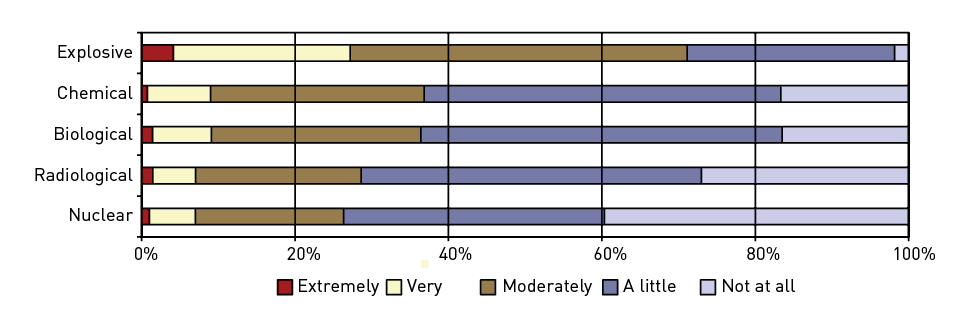
Figure 2. Concern that self or family would be affected in the event of each form of terrorism.
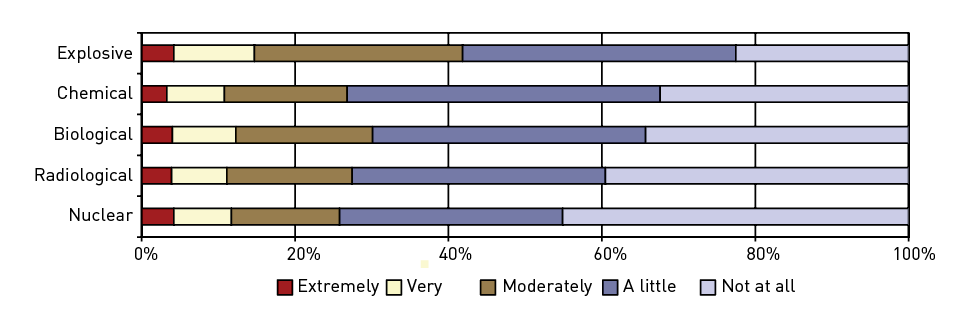
Most respondents believed the likelihood of terrorism occurring in Australia was low. As illustrated in Figure 1, the perceived likelihood of explosive terrorism was regarded as far greater than the CBRN forms of terrorism; with 27% of respondents reporting that they felt conventional terrorism was very or extremely likely to occur, compared to 9%, 9%, 7% and 7% for C, B, R, and N forms, respectively. This finding is very similar to previous Australian data from a representative sample of the NSW population in which 30% reported that a terrorist attack was very or extremely likely to occur (Stevens et al, 2009), and, again, suggests that Australians have slightly higher terrorism threat perceptions than the Canadian population (25%) (Lemyre et al 2005). However, Australian and Canadian threat likelihood for CBRN forms of terrorism was comparable; although the Canadian data suggests that their population felt that biological terrorism was more likely (15% compared to 9% in this study). One possible explanation for this might be a heightened sense of threat caused by actual events, e.g. anthrax attacks in the neighbouring United States.
Concern that self or family would be directly affected by a terrorism event was low, only around 11-15% felt very or extremely concerned. This is much lower than comparable research (Stevens et al, 2009) which found that 43% of the NSW population was concerned about being directly affected by a ‘terrorist attack’. A breakdown of the data showed differences between the three subgroups. The more heterogeneous ‘General’ group was more concerned (23% very or extremely concerned) compared to the ‘Contact’ group (10%) and ‘Young’ group (4%). With reference to the ‘not at all’ concerned responses in Figure 2, it can be seen that the percentage of respondents with negligible concern rose increasingly from 22% to 45% from E to C, B, R, and N forms respectively, suggesting that overall perceived vulnerability to the impacts of a terrorist event was low.
These threat perception findings have implications for those tasked with enhancing population vigilance and preparedness, since it is difficult to motivate individuals to prepare for, or be alert to, low probability events, especially if the negative consequences of such events on that individual or his/her loved ones are also regarded as low.
Figure 3 illustrates respondents’ level of confidence in the ability of a range of organisations and groups to respond to an R/N emergency event in their area.
Figure 3. Confidence in the ability of the listed organisations or groups to respond to an R/N emergency event, listed in order of mean confidence levels. Mean confidence was calculated using the 5-point response scale; 1=not at all, 2=a little, 3=moderately, 4=very, 5=extremely.

Overall, the highest levels of confidence were in ANSTO, the Fire Brigades and Defence/Military (62%, 59%, and 59% reported feeling very/extremely confident in each group, respectively). Respondents were the least confident in their employers’ ability to respond to incidents (only 27% very/extremely confident).
There were some subgroup differences, for instance, the ‘General’ group, was less confident in ANSTO’s ability to respond (42% very/extremely confident) compared to the ‘Contact’ (67%) or ‘Young’ groups (62%); possibly because ANSTO is an organisation less well known by this group.
The survey asked respondents to indicate the extent to which they had thought about or actually done things to prepare for an emergency event. These data are summarised in Figure 4.
Figure 4. Levels of personal preparedness for emergencies in general.
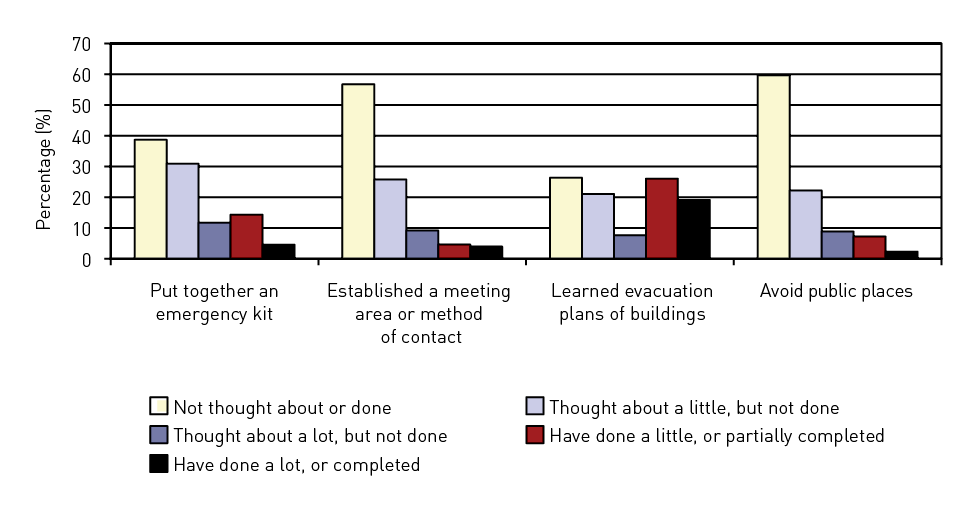
Our results suggest that levels of personal preparedness are low and that most respondents had neither thought about nor done anything to prepare, except in terms of learning about building evacuation plans, which possibly is due to mandatory fire drills in the workplace or at college/university. Only a small proportion of respondents had put together an emergency supply kit (19%) or established a meeting area or method of contact with family (9%). This is consistent with other Australian data (Nicolopoulos and Hansen, 2009) in which 11% of Western Australian respondents had discussed an agreed meeting place. Survey data from the US suggest the figures are around 30-40% for both preparation activities (Redlener et al, 2006; Wirthlin Report, 2004). For Londoners, these figures were higher still; 48% had gathered at least 4 out of 5 recommended emergency supplies and more than 50% had established a method of contacting family (Page et al, 2008).
Focus groups conducted with the Canadian population (Gibson et al, 2007) reveal some insights on people’s attitudes on preparedness. Many questioned the effectiveness of preparing for terrorism and whether it was possible to do at all. Some felt that excessive attempts to prepare can lead to paranoia and panic or, conversely, apathy. Given our finding that many Australian respondents perceive the radiological or nuclear threat to be remote, a more effective method of preparedness planning may be to utilise an ‘all hazards’ or generic emergency approach.
Respondents were asked to indicate how much they would trust certain groups and individuals for credible information in the event of an R/N emergency event. These data are presented in Figure 5.
Figure 5. Level of trust in the listed organisations and groups, in order of mean trust level. Mean level of trust was calculated using the 5-point response scale; 1=not at all, 2=a little, 3=moderately, 4=very, 5=extremely.
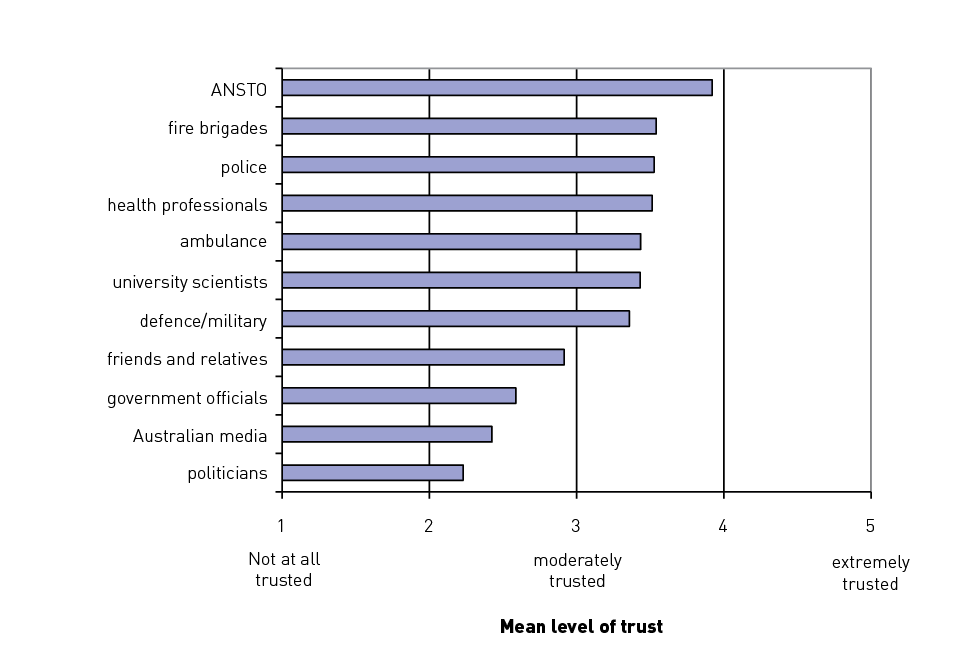
The most trusted sources of information were ANSTO, First Responders (fire, police, ambulance) and health professionals. The least trusted were the media and politicians. Inclusion of the ANSTO ‘Contact’ group in this study is likely to have increased awareness of ANSTO as an organisation in this context and therefore we would expect it to be less prominent in a general population sample. In general, results were similar to Canadian trends (Lemyre et al, 2005) although Australian media was ranked lower than Canadian media and university scientists ranked higher in Australia than in Canada. Interestingly, Europeans believe that scientists are the most trusted to give them information about nuclear safety (European Commission, 2007).
Trust, cooperative behaviour and adherence to advice provided by authorities are likely to be influenced by the level of openness in the communication strategies adopted by authorities. Following accidents at Chernobyl and Three Mile Island, attempts to minimise alarm or panic by restricting information about the risk led to rumours of conspiracy and secrecy (Sheppard et al, 2006). Similarly, inadequate or mixed information, or lack of awareness of existing perceptions and understandings during the anthrax attacks in the U.S. (2001) and Sarin attacks in Japan (1995) created public distrust, anxiety and fear (Sheppard et al, 2006). Distrust in government agencies is known to heighten perceived risks and hinder public health efforts, especially those that rely on the voluntary cooperation of the public such as evacuation, quarantine and vaccination (Sheppard et al, 2006).
Respondents indicated how likely they were to access different forms of media for credible information in the event of an R/N emergency event. These data, presented by sub-groups, are summarised in Figure 6.
Figure 6. Likelihood of turning to the listed forms of media for credible information in the event of a radiological or nuclear incident. Mean likelihood of use was calculated using the 5-point response scale; 1=not at all, 2=a little, 3=moderately, 4=very, 5=extremely.
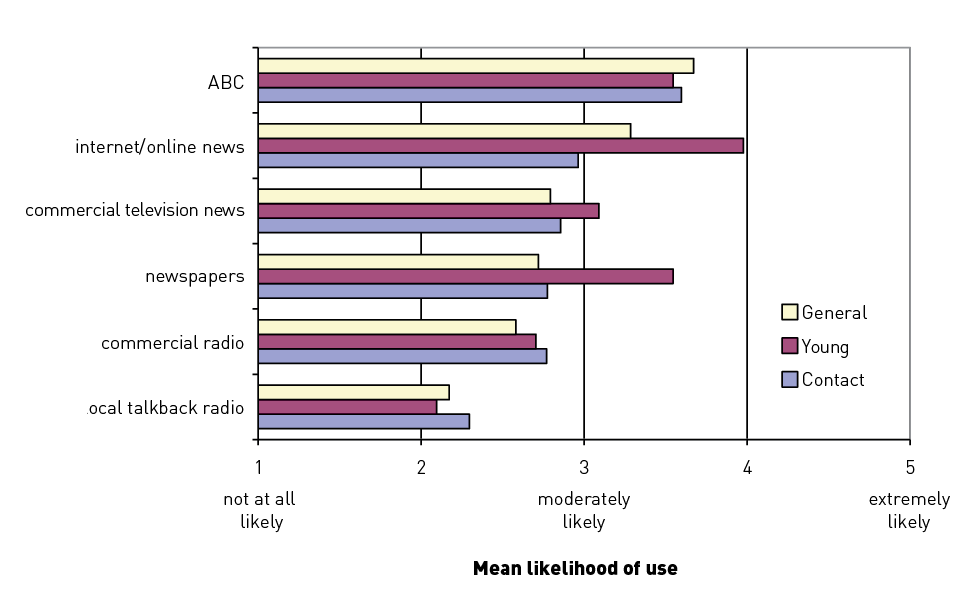
It appeared that the subgroups preferred different types of media. While the ABC received the highest ratings overall, there was a preference amongst the ‘Young’ group to use the internet and newspapers as credible sources of information whereas the ‘Contact’ and ‘General’ groups were more likely to go to the ABC. The results suggest that different communication channels may be necessary and further research is needed to determine the most appropriate communication channels to reach other sub-groups within the general population.
We presented 17 plausible behavioural responses to a radiological or nuclear incident (informed by past research, e.g. Lemyre et al, 2005, Becker, 2005, and discussion with subject matter experts). Respondents were asked how likely they would be to do each behaviour in the event of an R/N incident or accident. Factor analysis identified five clusters of behaviours. These were labelled Targeted Action, Helping Behaviour, Impulsive Behaviour, Pausing, and Long-term Change Behaviour. Table 2 summarises the responses within each factor cluster.
Table 2. The likelihood of respondents enacting the listed behaviours in the event of a radiological or nuclear incident occurring in their area. Mean likelihood was calculated using the 5-point response scale; 1=not at all, 2=a little, 3=moderately, 4=very, 5=extremely. (*Only 42% of respondents answered this one question as it was not applicable to all respondents).
| Behaviour type | Specific behaviour | Not at all/ a little (%) | Moderately (%) | Very/extremely (%) | Mean likelihood |
|---|---|---|---|---|---|
| Targeted Actions | Seek shelter indoors | 5.6 | 14.1 | 80.4 | 4.1 |
| Cover self with something – like a blanket or a coat | 32.2 | 22.9 | 44.9 | 3.1 | |
| Cover face to avoid inhaling or ingesting dust | 9.1 | 15.0 | 75.9 | 4.1 | |
| Call family members to check if they are OK | 1.3 | 6.5 | 92.1 | 4.5 | |
| Wash off radioactive material as soon as possible | 6.8 | 12.0 | 81.1 | 4.2 | |
| Helping Behaviour | Call the emergency services | 11.4 | 12.4 | 76.3 | 4.0 |
| Stop to help other people | 9.5 | 40.1 | 50.4 | 3.5 | |
| Band together with others to respond in whatever way is needed | 7.6 | 22.4 | 69.9 | 3.9 | |
| Volunteer to support emergency services | 28.1 | 33.0 | 38.9 | 3.2 | |
| Impulsive Behaviour | Try to get back home as soon as possible | 13.4 | 21.3 | 65.2 | 3.8 |
| Go home, pack, get away in car from the area | 27.8 | 28.8 | 43.4 | 3.3 | |
| Throw away stored food & water | 67.0 | 18.5 | 14.5 | 2.1 | |
| Pausing | Spend time gathering information that might guide your response | 10.8 | 23.2 | 66.0 | 3.8 |
| Remain & await instructions from the emergency services | 22.2 | 28.4 | 49.4 | 3.4 | |
| Long Term Change Behaviour | Decide not to have more children for fear of passing on genetic damage* | 63.5 | 20.4 | 16.0 | 2.3 |
| Move away permanently to another town, city, or area | 35.5 | 27.1 | 37.4 | 3.0 | |
| Have more frequent health checks | 12.5 | 19.3 | 68.2 | 3.8 |
The results indicate that an R/N incident is likely to result in a high demand on phone services; with many respondents being very or extremely likely to call family members (92%) and emergency services (76%).
It is encouraging that a significant proportion of respondents would consider helping others and would band together to respond (50% and 70% very/extremely likely, respectively), especially given the potential for greater radiation exposure and the fear and dread that such an event might evoke. Somewhat confusing was the finding that respondents seemed willing both to stop to gather information (66% very/extremely likely) but also likely to get home as soon as possible (65% very/extremely likely) and get away (43% very/extremely likely). Although this seeming contradiction is most likely due to the structure of the question, i.e. respondents rated a series of independent behaviours, the results suggest that there will not necessarily be a stampede to flee.
In the longer term, concerns about radiation exposure and the fear associated with not knowing whether they had been exposed may result in ongoing high demands on medical services with 68% of respondents very/extremely likely to have more frequent health checks. Over a third of respondents (37%) reported that they would be highly likely to move away permanently after an incident suggesting that many were not confident about living safely in an affected area without long term risk from radiation hazards.
These preliminary study findings identify many parallels between the Australian data presented here and other international data. This is the first study to our knowledge to measure public preparedness and anticipated response to an R/N event in an Australian sample and the consistencies with other findings suggest that our data, although from a limited sample, may be a reasonable and useful indicator of how the Australian population could respond to an R/N event. However, the study is not without its limitations. Due to the small sample size and the convenience sampling strategies employed, the data may be regarded as indicative, rather than representative, of the general population. There are also issues of non-response bias due to limited information on response rates in parts of the convenience sample. As mentioned earlier, this study was a large preliminary investigation developed to assess a wide range of issues with a broad selection of respondents. This initial study has led to funding for a representative population-based study (through the Research Support for Counter Terrorism program, funded through the National Security Science and Technology branch of Prime Minister & Cabinet). This will enable us to build on these initial findings and investigate how well they extend to the wider population, and more broadly to CBRNE and all hazards. In addition, this future research programme will develop risk communication strategies and messages and assess their applicability to this broader range of hazards.
The authors would like to acknowledge the assistance and support of the Australian Nuclear Science and Technology Organisation (ANSTO) and the NSW Fire Brigades in the development of this research project, and the members of the public who provided responses to the survey questionnaire.
Azjen, I. (1991) The theory of planned behaviour. Organizational Behavior and Human Decision Processes, 50, 179-211
Becker, S.M. (2004) Emergency communication and information issues in terrorist events involving radioactive materials. Biosecurity and Bioterrorism: Biodefense Strategy, Practice and Science, 2(2), 195-207
Becker, S.M. (2005) Addressing the psychosocial and communication challenges posed by radiological/nuclear terrorism: key developments since NCRP Report No. 138. Health Physics. 89(5), 521-530.
European Commission (2007) Europeans and nuclear safety: Special Eurobarometer 271
Gibson, S., Lemyre, L., Clement, M., Markon, M., & Lee, J. (2007), Biosecurity and Bioterrorism: Biodefense Strategy, Practice and Science, 5, 134-144
Havenaar, J. & van der Brink, W. (1997) Psychological Factors Affecting Health After Toxicological Disasters. Clinical Psychology Review, 17, 359-374
Lee, J. & Lemyre, L. (2009) A Social-cognitive perspective of terrorism risk perception and individual response in Canada. Risk Analysis, 29(9), 1265-1280.
Lemyre, L., Lee, J. & Krewski, D. (2005) Canadian National Public Survey of Perceived CBRN Terrorism Threat and Preparedness: A Research Report for the CBRN Research and Technology Initiative, Institute of Population Health, University of Ottawa, Ottawa.
Lemyre, L., Turner, M., Lee, J. & Krewski, D. (2006) Public Perception of Terrorism Threats and Related Information Sources in Canada: Implications for the Management of Terrorism Risks. Journal of Risk Research, 9(7), 755-774
Page, L., Rubin, J., Amlot, R., Simpson, J., and Wessely, S. (2008) Are Londoners prepared for an emergency? A longitudinal study following the London bombings. Biosecurity and Bioterrorism: Biodefense Strategy, Practice and Science, 6(4), 309-319
Redlener, I., Grant, R., Berman, D., Johnson, D., and Abramson, D. (2006) Where the American public stand s on terrorism, security and disaster preparedness. New York: National Centre for Disaster Preparedness. http://www.ncdp.mailman.columbia.edu/files/2006_ white_paper.pdf
Nicolopoulos, N., and Hansen, E. (2009) How well prepared are Australian communities for natural disasters and fire emergencies? The Australian Journal of Emergency Management, 24(1), 60-66
Rogers, M., Amlot, R., Rubin, G, Wessely, S. & Krieger, K. (2007) Mediating the social and psychological impacts of terrorist attacks: The role of risk perception and risk communications. International Review of Psychiatry, 19(3), 279-288
Sheppard, B., Rubin, G. J., Wardman, J. & Wessely, S. (2006) Terrorism and dispelling the myth of a panic prone public. Journal of Public Health Policy, 27, 219-245
Stevens, G., Agho, K., Taylor, M., Barr, M., Raphael, B. & Jorm, L. (2009) Terrorism in Australia: factors associated with perceived threat and incident-critical behaviours. BMC Public Health, 9:91
The Wirthlin Report (2004) U.S. public unprepared. The Wirthlin Report, December 2004, 13(5). Http://www.redcross.org/images/pdfs/WirthlinReport.pdf
Dr Mel Taylor, Dr Wendy Joung, Dr Barbara Griffin, Prof. Beryl Hesketh and Prof. Beverley Raphael are researchers in disasters, resilience, psychology and/or psychiatry based at the University of Western Sydney and Macquarie University. David Hill and Robert Chisari are ANSTO scientists employed in National Security Research. Dr Mel Taylor may be contacted at melanie.taylor@uws.edu.au.